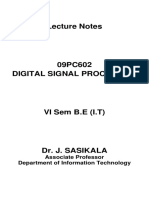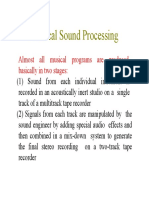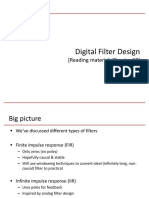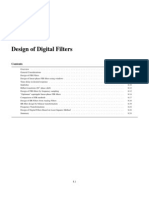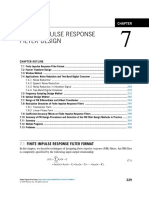0 ratings0% found this document useful (0 votes)
17 views7 pagesMusical Sound Processing
Uploaded by
71762103227Copyright
© © All Rights Reserved
We take content rights seriously. If you suspect this is your content, claim it here.
Available Formats
Download as PDF or read online on Scribd
0 ratings0% found this document useful (0 votes)
17 views7 pagesMusical Sound Processing
Uploaded by
71762103227Copyright
© © All Rights Reserved
We take content rights seriously. If you suspect this is your content, claim it here.
Available Formats
Download as PDF or read online on Scribd
You are on page 1/ 7
~
Web Resources
cients (d)) match the power spectral
the sequence of the FIR filter e
Program 16. 5.m
first the
nately,
applications,
mation [Kum93]. Unfor
true model order in many
Iusieal programs are produced in basicaly
‘in Seotion 1.4.1 that eet Fecorded in an acoustically inert studio on
each individual instrun nals from each track are manipulated by the von)
‘ ‘Then, the pe in a mix-down system to finally genes,
are combi (Ear86]. The audio effects are artificial
ip le78) ss \d they are increasingly being perto,
devices,
|, (Orf96].
Signal Procesing Tobe HOU IaMBe 9 — ju,
he
ly generated
med using
Web Resources
of Digital Signal Processing
ee Chapter 14: Applications
a(n] vet
; ee
3
i")
ost
; S % i * 1Sn Qn
OE Reet ean
(b) ©
|
Figure 14.15: Single echo filter: (a) filter structure, (b) typical impulse response, and (c) magnitude response for i
=8anda=08. |
Some of the special audio effects that can be implemented digitally are reviewed in this section.
14.5.1 Time-Domain Operations
Commonly used time-domain operations carried on musical sound signals are echo generation,
reverberation, flanging, chorus generation, and phasing. In each of these operations, the basic building
block is a delay.
Single Echo Filter
Echoes are simply generated by delay units, For example, the direct sound and a single echo appearing R
sampling periods later can be simply generated by the FIR filter of Figure 14.15(a), which is characterized
by the difference equation
yin] = xin] +axtn—R], lal< 1, (44)
or, equivalently, by the transfer function
Hiz)=1+@: (14.48)
In Eqs. (14.47) and (14.48), the delay parameter R denotes the time the sound wave takes to travel from
the sound source to the listener after bouncing back from the reflecting wall, whereas the parameter
with Ia < 1, represents the signal loss caused by propagation and reflection.
‘The impulse response of the single echo filter is sketched in Figure 14.15(b). The magnitude response
of a single echo FIR filter for @= 0.8 and R = 8 is shown in Figure 14.15(c). The magnitude response
exhibits R peaks and R dips in the range 0 < @< 27, with the peaks occurring at @= 2sk/R and the dips
occurring at @= (2k + 1)Z/R, k=0, 1, .. R~ 1, Because of the comblike shape of the magni
response, such a filter is also known as a comb filter. The maximum and minimum values of the magnitude
response are given by 1 + a= 1.8 and 1 ~ @=02, respectively,
Program 14.6 can be used to investigate the effect of a si i p.
Figure 1.16. nee ech on the a
‘Reproduced with permission of Prof. Dale Callahan, University of Alabama, Biri ai
145 Musical Sound Processing
‘. 823
v{n)
cel
Cealiegs 0 @5 30
Time index 0
14.16: Multiple echo filter generating N ‘:
meme ing N— 1 echoes: (a) filter structure and (b) impulse response with c= 0.8
Multiple Echo Filter
‘Togenerate a fixed number of multiple echoes
: spaced R sampling period i B
amplitudes, one can use an FIR filter with a transfer function Scene al ian le
Hq) = ltaz* +07 +.-+a%
(14.49)
An IR realization of this filter is sketched in Figure 14.16(a). The impulse response of multiple echo
fer with of = 0.8 for N = 6 and R = 4 is shown in Figure 14.16(0).
‘Aninfinite number of echoes spaced R sampling periods apart with exponentially decaying amplitudes
can be created by an IIR filter with a transfer function of the form
H@ = Vaz ® 402s hore +
1
lemme) lal <1, (14.50)
Figure 14.17(a) shows one possible realization of
samples for R = 4 are indicated in Figure 14.17(b).
sketched in Figure 14.17(c). The magnitude response
with the peaks occurring at @ k/R and the dips occurring at @= (2k + IAPR, k= 0,1, oo R= Le The
Sratimitm ahd roinirmum values of the magnitude response 2° given by Il ~ @) = 5 and 1(1+ @
0.5556, respectively. :
fundame y of the IIR multiple echo filte
frequency fa ing musical instrument, such as the drum beat. For a specified Fy the delay
fake aati 2 F/Fy sesulting in atime delay of RT= RIF, seconds [Or96].
ma He be ai A ewes Heck of multiple echos on the speech signal shown in
4.75 can be u
the above IIR filter whose first 61 impulse response
rhe magnitude response of this IR filter for R=7 is
exhibits R peaks and R dips in the range 0< @< 27,
hing the listener in a closed space, such as a concert hall,
4 1d reverberation. ‘The early reflections are
reacl
i on sound, early reflections, an
wham, AL.
University of Alabams Birmin;
1 of Eq, 14.50 is given by Fx=Fr/ web Rese
cS
Web Resources
Program 14.8.
+ 14: Applications of Digital Signal Process,
Chapte
824
atl
eae
osm € 1s a
Normalized frequency
()
nite number of echoes: (a) filter structure, (b) impulse response wih
Time index 9
(b)
Figure 14.17: IIR filter generating an infi
‘@= 08 for R=4, and (c) magnitude response with a= 0.8 for R = 7.
that are basically delayed and attenuated copies of the direct
sound, whereas the reverberation is composed of densely packed echoes. The sound recorded in an inert
studio is different from that recorded inside a closed space, and, as a result, the former does not sound
“‘patural” to a listener, However, digital filtering can be employed to convert the sound recorded in an inert
studio into a natural-sounding one by artificially creating the echoes and adding them to the original signal.
The TR comb filter of Figure 14.17(a) by itself does not provide natural-sounding reverberations for
two reasons [Sch62]. First, as can be seen from Figure 14.17(c), its magnitude response is not constant
for all frequencies, resulting in a “coloration” of many musical sounds that are often unpleasant for
listening purposes. Second, the output echo density, given by the number of echoes per second, generated
by a unit impulse at the input, is much lower than that observed in a real room, thus causing a “fluttering”
of the composite sound. It has been observed that approximately 1000 echoes per second are necessary
to create a reverberation that sounds free of flutter [Sch62]. To develop a more realistic reverberation, a
reverberator with an allpass structure, as indicated in Figure 14.17(a), has been proposed (Sch62]° Its
transfer function is given by
composed of several closely spaced echoes
ee
a
H() =
lear
lol< 4st)
In the steady state, the spectral balance of the sound signal remains unchanged due to the unity magnitude
response of the allpass reverberator.
Program 14.87 can be used to investigate the effect of an allpass reverberator on the speech signal
shown in Figure 1.16.
The IIR comb filter of Figure 14,17(a) and the allpass reverberator of Figure 14.14(a) are basie
reverberator units that are suitably interconnected to develop a natural-sounding reverberation. Figure
14.19 shows one such interconnection composed of a parallel connection of four IIR echo generators it!
cascade with two allpass reverberators [Sch62], By choosing different values for the delays in each
©The structures shown here are the canonic single multiplier realizat 3
See also Section 8.6.1 ation ofa firstorder allpass transfer function (Mit#8h
7Reproduced with permission of Prof. Dale Callahan, University of Alabama, Birmi oa
, musical Sound Processing
825
Pie
Time index n
pique 14.18: Allpass reverberator: (a) bl eS
Hock diagram representation and (b)
impulse re
sponse with c= 0.8 for R=4.
ra
1g reverberator scheme.
Figure 14.19: A proposed natural-soundiny
tants @, it is possible to arrive at a pleasant
ific closed space, such as a concert hall,
he multiplier cons
hove natural-sounding reverberator on the
Program 14 9.
‘tion (obtai
ion (obtained by adjusting R,) and
‘occurring in a spec!
und
Prose reverberation, duplicating that
|p, QB 14.9% can be used to vnvestigate the effect of te a
Signal shown in Figure 1.16.
Alabama, Birmingham, AL.
| Tillie lae oh dengaeine ,
"Reproduced with ra
You might also like
- 09PC602 - Digital Signal Processing VI Sem BE (IT) NotesNo ratings yet09PC602 - Digital Signal Processing VI Sem BE (IT) Notes219 pages
- A Maximum Likelihood Approach To Blind Audio De-ReverberationNo ratings yetA Maximum Likelihood Approach To Blind Audio De-Reverberation6 pages
- EEN 725 Advanced Digital Signal ProcessingNo ratings yetEEN 725 Advanced Digital Signal Processing29 pages
- Fundamentals of Digital Signal ProcessingNo ratings yetFundamentals of Digital Signal Processing26 pages
- Advanced Training Course On FPGA Design and VHDL For Hardware Simulation and SynthesisNo ratings yetAdvanced Training Course On FPGA Design and VHDL For Hardware Simulation and Synthesis17 pages
- Topic 8: Filter Design: IIR: ELEN E4810: Digital Signal ProcessingNo ratings yetTopic 8: Filter Design: IIR: ELEN E4810: Digital Signal Processing45 pages
- Digital Signal Processing Unit II: Digital Filters: Design and StructuresNo ratings yetDigital Signal Processing Unit II: Digital Filters: Design and Structures27 pages
- Finite and Infinite Response Design FilterNo ratings yetFinite and Infinite Response Design Filter16 pages
- K5rtlka3mu3e l8 Properties of Fourier Transforms During Lecture PDF Application PDFNo ratings yetK5rtlka3mu3e l8 Properties of Fourier Transforms During Lecture PDF Application PDF5 pages
- Fourier Series Method FIR Filter DesignNo ratings yetFourier Series Method FIR Filter Design16 pages

